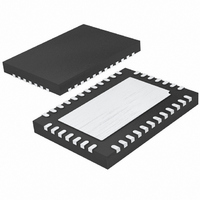LTC4245CUHF#PBF Linear Technology, LTC4245CUHF#PBF Datasheet - Page 27

LTC4245CUHF#PBF
Manufacturer Part Number
LTC4245CUHF#PBF
Description
IC CNTRLR HOT SWAP 38-QFN
Manufacturer
Linear Technology
Type
Hot-Swap Controllerr
Datasheet
1.LTC4245CUHFPBF.pdf
(36 pages)
Specifications of LTC4245CUHF#PBF
Applications
CompactPCI™
Internal Switch(s)
No
Voltage - Supply
3.3V, 5V, 12V
Operating Temperature
0°C ~ 70°C
Mounting Type
Surface Mount
Package / Case
38-WFQFN, Exposed Pad
Family Name
LTC4245
Package Type
QFN EP
Operating Supply Voltage (min)
2.25/4.25/10.2/-10.2V
Operating Supply Voltage (max)
0/10/20/-20V
Operating Temperature (min)
0C
Operating Temperature (max)
70C
Operating Temperature Classification
Commercial
Product Depth (mm)
5mm
Product Length (mm)
7mm
Mounting
Surface Mount
Pin Count
38
Lead Free Status / RoHS Status
Lead free / RoHS Compliant
Available stocks
Company
Part Number
Manufacturer
Quantity
Price
APPLICATIO S I FOR ATIO
The inputs to the above equations are pre-calculated in
Table 3.
Table 3. t
Equations 8 to 11, when applied to the four supplies
yields:
Table 4. t
Therefore the TIMER capacitance value is constrained by
the –12V supply inrush current. The total time (t
t
value to be:
So a value of 2.2μF (±10%) should suffi ce.
4. The next step is to select MOSFETs for the four sup-
plies. The IRF7413 is selected for 12V, Si7880DP for 5V
and 3.3V, and Si4872 for –12V Supply. The Si7880DP’s
on resistance is less than 4.25mΩ for V
junction temperature of 25°C.
Since the maximum load current requirement for the
3.3V supply is 7A, the steady-state power the MOSFET
may be required to dissipate is 208mW. The Si7880DP
has a maximum junction-to-ambient thermal resistance
of 65°C/W. If a maximum ambient temperature of 50°C
is assumed, this yields a junction temperature of 63.5°C.
According to the Si7880DP’s Normalized On-Resistance
vs Junction Temperature curve, the device’s on-resistance
can be expected to increase by about 15% over its room
temperature value. Recalculation of the steady-state values
of R
4.9mΩ and 67°C, respectively. The I • R drop across the
3.3V sense resistor and series MOSFET at maximum load
current under these conditions will be less than 52mV.
3
SUPPLY
SUPPLY
) is approximately 30ms. Equation 4 gives the capacitor
–12V
3.3V
12V
–12V
C
5V
3.3V
12V
5V
T(MIN)
ON
3
3
and junction temperature yields approximately
Calculation Inputs
Calculation Results
V
3.3V
12V
12V
≥ 30ms / K
5V
OUT
3.3ms
2.6ms
2.6ms
3.6ms
t
31
V
6V
3V
2V
6V
U
FB
1.4ms
4.5ms
1.5ms
3.7ms
TMCAP(MIN)
t
32
(dI/dt)
430mA/ms
602mA/ms
60mA/ms
30mA/ms
U
(MIN)
2.3ms
2.6ms
1.4ms
3.7ms
t
33
= 1.5μF
W
I
FBL(MIN)
198mA
109mA
1.13A
1.58A
GS
t
34
0
0
0
0
= 4.5V and a
U
TOTAL(t
I
FBH(MIN)
792mA
396mA
6.22A
8.71A
1
9.7ms
5.5ms
11ms
7ms
+ t
(12)
2
3
)
+
The energy dissipated in the MOSFET during power-up
is the same as that stored into the load capacitor. The
average power dissipated in the MOSFET is:
The 12V MOSFET’s single-pulse θ
its Transient Thermal Impedance Graph, is 3°C/W for a
time, t
the 12V MOSFET temperature rise during power-up is
3°C. The other supplies show a smaller rise in MOSFET
temperature than this value.
When a supply powers-up into a short-circuit at the output,
the supply current rises linearly to the lower foldback level
and stays there till the timer expires and the MOSFETs are
shut-off. To simplify calculations it will be assumed that
the MOSFET conducts the lower foldback current from
the moment it turns on. This time (t
the MOSFET is conducting current minus a correction
for the assumption, which is half of the time required for
the current to rise from zero to the lower foldback level.
Therefore:
The 1.5 • ΔV
factor and the time spent in ramping the starting negative
current limit to zero. t
for all four supplies. The maximum power dissipated in
the MOSFET is given by:
P
for the 5V MOSFET is 3.25°C/W. Therefore the MOSFET
temperature rise during power-up into a 5V
circuit is 52°C. Similar calculations show that the other
supplies experience a smaller MOSFET temperature rise.
The θ
Transient Thermal Impedance Graph for a duty cycle of
0.02, which is the case when the LTC4245 is confi gured
for auto-retry on overcurrent faults.
SC(MAX)
P
P
t
( . •
ON
SC MAX
1 5 ∆
SC MAX
JA(MAX)
3
(
(
=
, of 7ms. P
C
for the 5V supply is 3.2A • 5V, or 16W. θ
L
V
)
)
2
SNS FBL
=
=
•
G
SNS(FBL)(MAX)
•
value is read from the MOSFET datasheet’s
V
I
C
t
SS
FBL MAX
OUT
3
2
(
T MAX
(
•
ON
(
I
SS MAX
) ) (
MAX
is calculated to be 1W and therefore
SC(MAX)
)
(
)
•
•
K
)
V
TMCAP MAX
) •
)
OUT
term is due to the correction
C
turns out to be about 58ms
SS MIN
(
(
JA(MAX)
SC
)
)
–
) is the actual time
LTC4245
, as read from
OUT
27
JA(MAX)
short-
(15)
(14)
4245fa
(13)













